
Boraginaceae, the borage or forget-me-notfamily, includes about 2,000 species of shrubs, trees, and herbs in 146 to 156 genera with a worldwide distribution.

Cordia is a genus of flowering plants in the borage family, Boraginaceae. It contains about 300 species of shrubs and trees, that are found worldwide, mostly in warmer regions. Many of the species are commonly called manjack, while bocote may refer to several Central American species in Spanish.
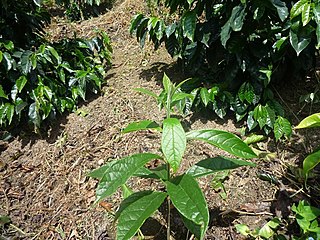
Cordia alliodora is a species of flowering tree in the borage family, Boraginaceae, that is native to the American tropics. It is commonly known as Spanish elm, Ecuador laurel, cypre or salmwood. It can reach 35 m in height.

Schinus is a genus of flowering trees and tall shrubs in the sumac family, Anacardiaceae. Members of the genus are commonly known as pepper trees. The Peruvian pepper tree is the source of the spice known as pink peppercorn.

Parkinsonia, also Cercidium, is a genus of flowering plants in the pea family, Fabaceae. It contains about 12 species that are native to semi-desert regions of Africa and the Americas. The name of the genus honors English apothecary and botanist John Parkinson (1567–1650).

Entandrophragma is a genus of eleven known species of deciduous trees in the family Meliaceae.

Cordia sebestena is a shrubby tree in the borage family, Boraginaceae, native to the American tropics. It ranges from southern Florida in the United States and the Bahamas, southwards throughout Central America and the Greater Antilles. Common names have included siricote or kopté (Mayan) in 19th Century northern Yucatán, scarlet cordia in Jamaica, and Geiger tree in Florida.
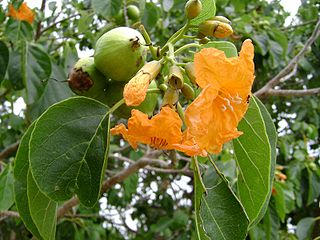
Cordia subcordata is a species of flowering tree in the borage family, it can be found growing in eastern Africa, South Asia, Southeast Asia, northern Australia and the Pacific Islands including Hawaii. The plant is known by a variety of names including kou, beach cordia, sea trumpet, and kerosene wood, among others.
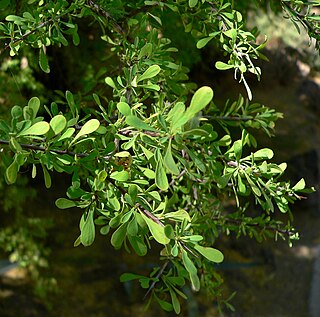
Condalia is a genus of spiny shrubs in the tribe Rhamneae of the buckthorn family, Rhamnaceae. It was named for Antonio Condal, an 18th century Spanish physician. Members of the genus are native to tropical and subtropical deserts and xeric shrublands in North and South America. The ranges of each species vary considerably; some are confined to only a few square miles, while others can be found on an area up to 1,000 sq mi (2,600 km2).

The "Pernambuco" interior forests is an ecoregion of the Tropical and subtropical moist broadleaf forests Biome, and the South American Atlantic Forest biome. It lies in eastern Brazil between the coastal Pernambuco coastal forests and the dry Caatinga shrublands of Brazil's interior.
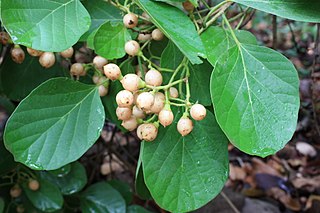
Cordia myxa, the Assyrian plum, is a mid-sized, deciduous tree in the borage family (Boraginaceae), native to Asia. It produces small, edible fruit and is found in warmer areas across Africa and Asia. Other common names in various languages include lasura, leswa,laveda, pidar, panugeri, naruvilli, geduri, spistan, burgund dulu wanan and ntege.

Echium pininana, commonly known as the tree echium, pine echium, giant viper's-bugloss, or tower of jewels, is a species of flowering plant in the borage family Boraginaceae. It is endemic to the Canary Islands, where it is restricted to the island of La Palma. Echium pininana is an endangered species, and is listed in Appendix I to, and is therefore protected under, the Convention on the Conservation of European Wildlife and Natural Habitats. The specific epithet pininana is Latin for "small pine", though E. pininana is neither closely related to the pine, nor does it resemble that plant.
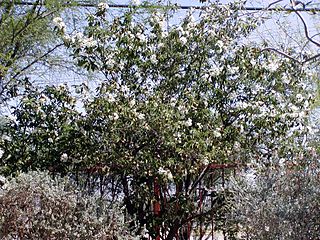
Cordia boissieri is a white-flowered, evergreen shrub or small tree in the borage family (Boraginaceae). Its native range extends from southern Texas in the United States south to central Mexico. Common names include anacahuita, Mexican olive, white cordia, and Texas wild olive. It is named after the Swiss explorer and botanist Pierre Edmond Boissier.
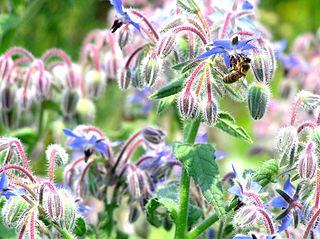
Boraginoideae is a subfamily of the plant family Boraginaceae s.s, with about 42 genera. That family is defined in a much broader sense in the Angiosperm Phylogeny Group (APG) system of classification for flowering plants. The APG has not specified any subfamilial structure within Boraginaceae s.l.

Cordia dichotoma is a species of flowering tree in the borage family, Boraginaceae, that is native to the Indomalayan realm, northern Australia, and western Melanesia.

Cordia africana or Sudan teak is a mid-sized, white-flowered, evergreen tree in the borage family (Boraginaceae), native to Africa. It produces edible fruit, and its wood is used for drums or other carpentry.

Cordia lutea, known as yellow cordia or in Spanish muyuyo, is a shrubby plant in the borage family (Boraginaceae), native to the Galápagos Islands, mainland Ecuador, Peru, and the Marquesas Islands in Polynesia. Common in the arid lowlands of the Galápagos, its relatively large yellow flowers make it easy to identify.
Cordia salicifolia, also called Cordia ecalyculata and chá de bugre, is a species of evergreen flowering tree in the borage family, Boraginaceae, that occurs mainly in Brazil and is used as a medicinal plant. Its red fruit, which resembles a coffee bean and contains caffeine, is roasted and brewed as a coffee substitute.

















